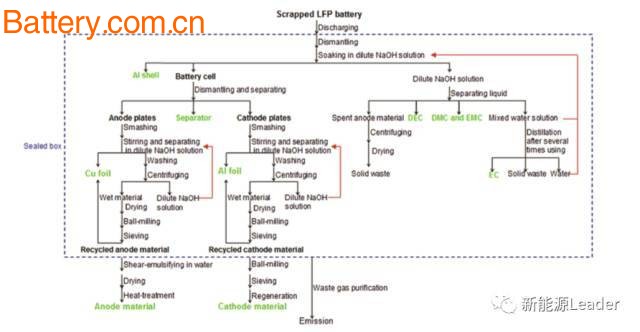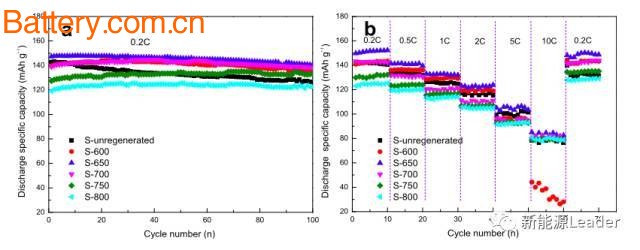Lithium iron phosphate has good cycle performance, low price, good safety and potential for fast charging. Therefore, with the rapid development of the domestic electric vehicle industry, the demand for lithium iron phosphate battery has also increased rapidly. Lithium iron phosphate batteries are basically used in automobiles with higher safety requirements. As these lithium iron phosphate batteries entered the end of life, we had to face a tough problem - the recycling of used batteries. Lithium iron phosphate battery recycling has its own characteristics. Compared with other layered structural materials, lithium iron phosphate material has a more stable olivine structure, so it is very stable, even if all Li+ is extracted from the interior of lithium iron phosphate material during charging. Lithium iron phosphate material can still maintain the FePO4 structure without structural collapse and transformation, so the decline of lithium iron phosphate battery during the cycle is generally not caused by the loss of positive and negative active materials, Neelima of Munich University of Technology, Germany Paul and his team used neutron diffraction to study long-term lithium iron phosphate batteries (LFP/MCMB), suggesting that the main cause of the decline in lithium iron phosphate battery life is due to SEI membrane remodeling during cycling. Li consumption caused by growth [1]. Neelima Paul used a neutron diffraction method to analyze a battery stored in the cycle 1C for 4,750 cycles and at 23 °C for 2 years (20% SoC). It was found that even after the battery was completely discharged (the positive electrode was in the lithium-deposited state, the negative electrode was at Delithiation state), but a considerable proportion of FePO4 was observed in the diffraction peak of the positive electrode, the ratio of LFP:FP was 67:33 in the battery of 4,750 cycles, and the ratio of LFP:FP was 75 in the battery stored for 2 years. :25, and no diffraction peak of LiC6 was observed in the diffraction peak of the negative electrode. This result shows that a considerable proportion of Li+ “disappears out of the air†in the cycle of lithium iron phosphate battery, and also indicates that the positive and negative active materials can participate in the charge and discharge reaction during the cycle, and no active substance occurs. Loss, so the main cause of the decline of lithium iron phosphate battery is the loss of Li during the cycle. Since the LFP material can maintain the stability of the crystal structure during the battery cycle, for the recycling of the discarded LFP battery, we only need to supplement the appropriate Li to regain the good performance of the LFP material, which can greatly reduce The production cost of LFP materials reduces environmental pollution. Xuelei Li et al. [2] of Tianjin University of Technology designed a green recycling process for recycling lithium iron phosphate batteries. The specific process steps are shown in the figure below. The biggest feature of this step is the low cost, high efficiency and environmentally friendly recycling for the characteristics of lithium iron phosphate material. From the flow chart, we can see that the process not only realizes the recovery and regeneration of the positive LFP material and the negative graphite material, but also recovers materials that are difficult to recover such as electrolyte. Xuelei Li et al. first discharged lithium iron phosphate battery for discharge and disassembly, and the residual electrolyte was treated with low concentration of NaOH. According to the physical characteristics of solvent density, solubility and boiling point in the electrolyte, The separation of DMC, DEC and EC, etc., the solvent salt LiPF6 is decomposed in an aqueous solution, as shown in the following formula, and then it can be recovered by filtration. After the separated positive LFP material is mixed with a certain amount of Li2CO3 in this process, the regenerated LFP material can be obtained by heat treatment at different temperatures in an Ar/H2 atmosphere. In order to ensure good performance of recycled and recycled LFP materials, Xuelei Li performed LFP regeneration experiments at 600, 650, 700, 750 and 800 degrees Celsius, and performed performance tests using button-type half-cells. The results are shown in the table below. . From this table, we can see that the capacity of LFP material without regeneration treatment is about 143mAh/g, and the capacity of LFP material after 650 degrees Celsius treatment has increased to 147mAh/g, but after other temperature treatment, LFP The capacity of the material has declined to varying degrees. At the same time, we also noticed that the first time the material after regeneration is significantly lower than the LFP material without regeneration, which is mainly due to the presence of heterogeneous phase in the regenerated LFP. The Xuelei Li study shows that the heat treatment time can be extended by appropriate Improve the first efficiency of LFP materials. Studies on the electrochemical performance of regenerated LFP show that heat treatment can significantly improve the cycle performance of LFP materials (as shown in Figure a below), while heat treatment also significantly improves the rate performance of LFP materials (as shown in Figure b below). The method of recycling lithium iron phosphate battery proposed by Xuelei Li combines the structural stability of lithium iron phosphate material, and does not use the traditional method of acid treatment and recovery of valuable elements, but directly regenerates it. Low-cost, high-performance recycled LFP materials are obtained, and the process also realizes the recovery of electrolytes and other materials, greatly reducing the environmental pollution caused by the recovery process of lithium iron phosphate batteries. As a large number of lithium iron phosphate power batteries are scrapped and enter the recycling stage, the battery recycling market has experienced explosive growth. In order to avoid secondary pollution to the environment during recycling, we need to adopt a more green recycling method. Xuelei Li's research provides us with useful lessons.
24 Inch Ukulele,Ukulele 23 Inch,23 Inch Ukulele,Tayste Ukulele GUANGZHOU GIDOO MUSICAL INSTRUMENT CO.,LTD , https://www.kymusicstand.com




January 20, 2024